
Anthony the Great was a Christian monk from Egypt, revered since his death as a saint. He is distinguished from other saints named Anthony, such as Anthony of Padua, by various epithets: Anthony of Egypt, Anthony the Abbot, Anthony of the Desert, Anthony the Anchorite, Anthony the Hermit, and Anthony of Thebes. For his importance among the Desert Fathers and to all later Christian monasticism, he is also known as the Father of All Monks. His feast day is celebrated on 17 January among the Eastern Orthodox and Catholic churches and on Tobi 22 in the Coptic calendar.

Martin of Tours, also known as Martin the Merciful, was the third bishop of Tours. He has become one of the most familiar and recognizable saints in France, heralded as the patron saint of the Third Republic. He is the patron saint of many communities and organizations across Europe. A native of Pannonia, he converted to Christianity at a young age. He served in the Roman cavalry in Gaul, but left military service at some point prior to 361, when he became a disciple of Hilary of Poitiers, establishing the monastery at Ligugé. He was consecrated as Bishop of Caesarodunum (Tours) in 371. As bishop, he was active in the suppression of the remnants of Gallo-Roman religion, but he opposed the violent persecution of the Priscillianist sect of ascetics.

Saint Valentine was a 3rd-century Roman saint, commemorated in Western Christianity on February 14 and in Eastern Orthodoxy on July 6. From the High Middle Ages, his feast day has been associated with a tradition of courtly love. He is also a patron saint of Terni, epilepsy and beekeepers. Saint Valentine was a clergyman – either a priest or a bishop – in the Roman Empire who ministered to persecuted Christians. He was martyred and his body buried on the Via Flaminia on February 14, which has been observed as the Feast of Saint Valentine since at least the eighth century.

Saint Giles, also known as Giles the Hermit, was a hermit or monk active in the lower Rhône most likely in the 7th century. Revered as a saint, his cult became widely diffused but his hagiography is mostly legendary. A town that bears his name grew up around the monastery he purportedly founded, which became a pilgrimage centre and a stop on the Way of Saint James. He is traditionally one of the Fourteen Holy Helpers.
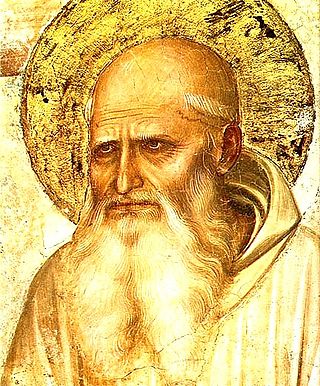
Romuald was the founder of the Camaldolese order and a major figure in the eleventh-century "Renaissance of eremitical asceticism". Romuald spent about 30 years traversing Italy, founding and reforming monasteries and hermitages.

Godric is the tenth novel by the American author and theologian, Frederick Buechner. Set in the eleventh and twelfth centuries, the novel tells the semi-fictionalised life story of the medieval Roman Catholic saint, Godric of Finchale. It was first published in 1980 by Atheneum, New York, and was a finalist for the 1981 Pulitzer Prize.

The Sanctuary of Saint Michael the Archangel is a Roman Catholic shrine on Mount Gargano, Italy, part of the commune of Monte Sant'Angelo, in the province of Foggia, northern Apulia. It has the dignity of a minor basilica.
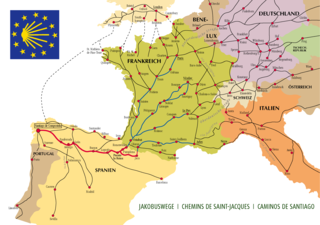
The Camino de Santiago, or in English the Way of St. James, is a network of pilgrims' ways or pilgrimages leading to the shrine of the apostle James in the cathedral of Santiago de Compostela in Galicia in northwestern Spain, where tradition holds that the remains of the apostle are buried.

The Via Francigena is an ancient road and pilgrimage route running from the cathedral city of Canterbury in England, through France and Switzerland, to Rome and then to Apulia, Italy, where there were ports of embarkation for the Holy Land. It was known in Italy as the "Via Francigena" or the "Via Romea Francigena". In medieval times it was an important road and pilgrimage route for those wishing to visit the Holy See and the tombs of the apostles Peter and Paul.

Hilarion the Great (291–371) was an anchorite who spent most of his life in the desert according to the example of Anthony the Great (c. 251–356). While Anthony is considered to have established Christian monasticism in the Egyptian Desert, Hilarion is considered by his biographer Jerome to be the founder of Palestinian monasticism and venerated as a saint exemplifying monastic virtues by the Orthodox and the Roman Catholic Church.
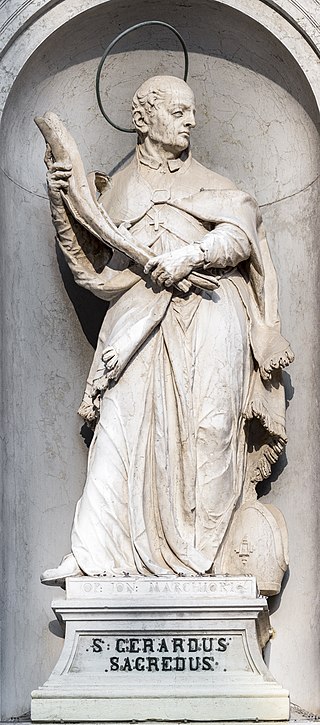
Gerard or Gerard Sagredo was the first bishop of Csanád in the Kingdom of Hungary from around 1030 to his death. Most information about his life was preserved in his legends which contain most conventional elements of medieval biographies of saints. He was born in a Venetian noble family, associated with the Sagredos or Morosinis in sources written centuries later. After a serious illness, he was sent to the Benedictine San Giorgio Monastery at the age of five. He received excellent monastic education and also learnt grammar, music, philosophy and law.

Paula of Rome was an ancient Roman Christian saint and early Desert Mother. A member of one of the richest senatorial families which claimed descent from Agamemnon, Paula was the daughter of Blesilla and Rogatus, from the great clan of the Furii Camilli. At the age of 16, Paula was married to the nobleman Toxotius, with whom she had four daughters, Blaesilla, Paulina, Eustochium, and Rufina. She also had a boy, also named Toxotius. As a disciple of Jerome, she is considered the first nun in the history of Christianity.

Drogo of Sebourg, also known as Druon, Dreux, Dron, Droon, and Drogon, is a Flemish saint. He was born in Epinoy, County of Artois in the French part of the County of Flanders, and died in Sebourg, France. He is known as the patron saint of shepherds and coffee, and his feast day is on April 16.
Juan de Ortega, better known as Saint John the Hermit, was a Spanish priest and hermit. A disciple of Dominic de la Calzada, he is best known for repairing roads and bridges along the Camino de Santiago. He also built a hospice as a shelter for pilgrims and founded the monastery of San Juan de Ortega.

Christianity has a strong tradition of pilgrimages, both to sites relevant to the New Testament narrative and to sites associated with later saints or miracles.

Leoluca, also Leone Luca, Leo Luke of Corleone, Saint Leoluca, or Luke of Sicily was the abbot and wonderworker of the monastery of Mount Mula in Calabria, and a founder of Italo-Greek monasticism in southern Italy. He is venerated as a saint in the Roman Catholic and Eastern Orthodox churches.

Fridianus, was an Irish prince and hermit, fl. 6th century. Tradition names him as a son of King Ultach of Ulster. He later migrated to Italy, where he was appointed as Bishop of Lucca. The Basilica of San Frediano in the city is dedicated to him, as are churches in Florence.
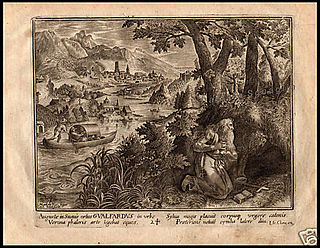
Gualfardo of Verona (1070–1127) was a Swabian artisan, trader, and hermit who lived around Verona. A hagiographical vita (biography) was composed, according to the Bollandists, within decades of his death, probably towards the end of the twelfth century. In the early sixteenth century he was venerated as the patron saint of the harnessmakers' guild at Verona.

Nicholas the Pilgrim, sometimes Nicholas of Trani, is a saint of the Roman Catholic and Eastern Orthodox Church.
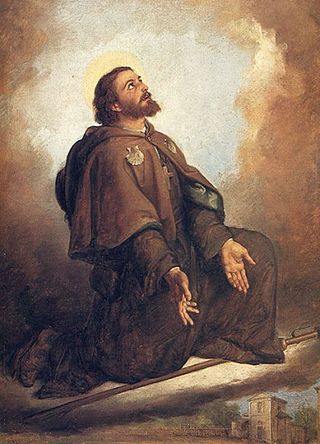
Amato Ronconi was an Italian Catholic who became a professed member of the Secular Franciscan Order. Ronconi lived a life of penitence and dedicated all his works to the poor through the construction of chapels and hospitals – one such hospital still exists in his home of Rimini. The residents in this town recognised his good deeds and hailed Ronconi as a saint in his own lifetime.


















